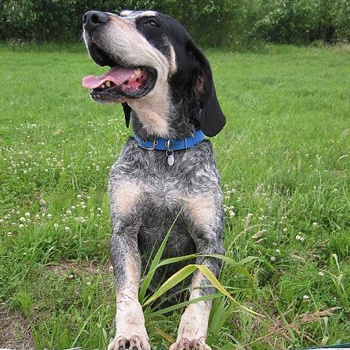Grand Bleu de Gascogne

The Grand Bleu de Gascogne is one of the original bloodhound breeds in Europe. In the Middle Ages, noblemen often kept a pack of these fine dogs to use in their favourite pursuit, hunting. Their melodious howls would often be heard as they chased deer and other large game through the countryside. However, the breed lost much of its popularity in France between the 18th and 20th centuries. Instead, the mantle of preserving the breed fell to the United States where they had been exported to French colonies. Here the breed successfully managed to make it into the modern age.
Grand Bleu are extremely active dogs who are still most suited to a working environment or at least a rural setting. They are pack animals who would prefer to spend as much time as possible with their families. Any alone time will probably be spent practising their howling. However, with the right amount of exercise and companionship, a Grand Bleu will prove to be a friendly hunting companion who is always ready to follow a scent and set off on another adventure.
About & History
The Grand Bleu de Gascogne is one of the many European breeds that is thought to have its roots in dogs spread around the continent by Phoenician traders. The earliest record of the breed comes from 14th century France where the Comte de Foix had a pack of hunting dogs. Throughout the centuries, the Grand Bleu has functioned as a pack-hunting dog. Nobles in medieval Europe kept packs of hounds for hunting large game such as deer, wolves and boar. Their primary purpose was to use their excellent noses to find their quarry. Once an animal had been found, they used their stamina to drive them to exhaustion, communicating through howls and deep barks.
The breed has a relatively long history in the US as well, indeed, there are now thought to be more Grand Bleu in the United States than in their native France. The first Grand Bleu crossed the pond in 18th century. General Lafayette, a French nobleman who fought with the Americans in the War of Independence, gave seven Grand Bleu to George Washington in 1785, who commented that their voices were so musical they reminded him of Moscow’s bells.
The Grand Bleu’s heydays of hunting with the landed gentry in France couldn’t last forever. Their numbers began to decline as the number of wolves reduced. They were expensive dogs to keep and many noblemen began switching to other breeds to keep their costs down. The breed took a further hit during and after the French Revolution when many French noblemen were unseated from their estates. In modern France, the Grand Bleu is a rare breed.
The Grand Bleu was such a good hunting hound that they were used in the development of other scent-hound breeds. Grand Bleu heritage can be found in diverse breeds, such as the Bluetick Coonhound of Louisiana, the Dumfriesshire Hound in the UK and the Basset Bleu de Gascogne to whom they passed on their distinctive coat colouring.
Appearance

A Grand Bleu de Gascogne is a large dog standing at 65 to 72cm tall and weighing 35 to 39 kg. They are instantly recognisable as bloodhound hunting dogs due to their long ears, which hang down to the base of the neck. Their muzzles have a boxy appearance due to their jowls, although this trait is less accentuated than in some other bloodhound breeds. Grand Bleu have muscular, lean bodies with long legs. They have deep chests which follows into the abdomen with a noticeable abdominal tuck.
The Grand Bleu’s coat is a complex of three different colours. Their base colouring is white mottled with black, giving them a marbled appearance. Larger black patches are imposed over this background on the chest and abdomen. The head is coloured black at the sides with a white, mottled streak down the centre. Their cheeks are usually tan, as is each ‘eyebrow’. Tan fur also covers their limbs towards the paws and parts of the sternum.
Character & Temperament
Grand Bleu de Gascogne are gentle giants. Although they can be aloof with strangers, once they’re comfortable their natural friendliness comes to the fore. It’s important to note that Grand Blue are still primarily kept as hunting dogs and their relaxed temperament may be dependent on enough exercise. Since they have not been bred for domestic settings, their ability to settle into family life will depend on experienced owners willing to dedicate enough time to exercising and stimulating their pet. That said, they are not aggressive dogs.
As pack dogs, they are highly sociable and enjoy being accompanied at all times. A lonely Grand Bleu will be a noisy Grand Bleu and although George Washington might have loved their voices, the constant baying of a hound might wear thin with close neighbours. They are most suited to a rural setting where they can accompany their owners on their daily tasks and get their fill of physical activity.
Trainability
Grand Bleu de Gascogne are intelligent hounds but this doesn’t make them easy to train. They are independent dogs with their own ideas about what to do. Once they’ve picked up a scent, they become so focused it can be hard to recall them. Training is essential for this breed to keep them under control. Time and patience are the key to successful training.
They are sensitive animals, so gentle correction will lead to better results than a heavy handed approach. Socialisation is an important aspect of training a Grand Bleu. Exposing them to as many people, dogs and environments will help them become confident adults.
Health
Grand Bleu de Gascogne are generally healthy dogs that haven’t developed the same levels of congenital health problems as other pedigree breeds. They have an average life expectancy of 10 to 12 years. Their downfall comes in their size and deep chests, which predisposes them to one condition:
Gastric Dilatation Volvulus (GDV)
Gastric Dilatation Volvulus (GDV), or simply 'Bloat', is a condition where the stomach begins to fill with gas and fluid. This can progress to GDV where the stomach turns on its axis, blocking passage of fluid through the intestines and escape of gas through the oesophagus. The enlarging stomach reduces the return of blood to the heart by pressing on the vena cava and can cause difficulty breathing.
Without immediate surgical intervention, GDV is a fatal condition. The cause of GDV is not fully known but the condition is more common in larger breeds and may be linked to exercise after large meals. Symptoms to look out for include restless behaviour, signs of abdominal pain and attempts to vomit without producing anything.
Exercise and Activity Levels
As hunting dogs, Grand Bleu were expected to chase athletic animals, such as deer and wolves. They have retained their immense stamina into the modern age. For them to be a happy, relaxed dog in the home, a Grand Bleu requires at least 2 hours of exercise a day. Their intelligence means that they also need mental stimulation. Their exercise should be off the lead whenever possible to allow them to indulge their scenting instincts. If your Grand Bleu isn’t getting enough exercise, they’ll let you know through destructive behaviour at home.
When not out on a walk, Grand Bleu should be given ready access to a garden where they can expend some energy. Any fencing should be extremely secure, as they will exploit any weakness to escape and roam. A large scenthound on the loose is capable of causing plenty of trouble and their stamina might carry them for miles before you realise they’re gone!
Grand Bleu are a slow maturing breed. They will not reach their full size until 2 years old. Owners should be careful not to exercise them too much as puppies. Care should be taken not to let them jump down from furniture or go up and down stairs too much to avoid exerting pressure on the growth plates.
Grooming
A Grand Bleu’s short coat is low maintenance so what you save in grooming time you can spend exercising them. Weekly brushing should suffice to keep their coat spruced up. They might require more regular brushing during seasonal shedding in the Spring and Autumn. Their ears should be checked regularly for a build up of wax and any early signs of infection.
Famous Grand Bleus de Gascogne
Since Grand Bleu de Gascogne are pack dogs, no individuals have shone through. Their fame is limited to the list of historical figures who have owned Grand Bleu packs, such as George Washington and King Henry IV of France.
Cross-Breeds
Although the Grand Bleu de Gascogne has contributed to the development of many other breeds, no modern cross-breeds have been created.

